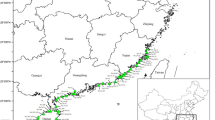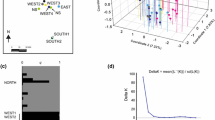Abstract
Clonal plantations of Thujopsis dolabrata var. hondae have been established in Ishikawa Prefecture, Japan, since at least the 1800s. Historical planting of the species has led to the development of vegetatively propagated local cultivars, which originated from ‘donor’ trees that have often been conserved in sacred groves or avenues at shrines and temples. These donor trees must have been selected from natural populations. In this study, we estimated the origin and genetic variability of clones identified among old planted trees and clonal plantations of T. dolabrata var. hondae, using 19 microsatellite markers. We discovered 12 clones among old planted trees, including 5 identical to members of a set of 14 we previously identified in plantations (giving 21 clones in total). Based on analyses combining assignment and exclusion tests, we inferred origins of 8 of those 21 clones: 6 may have originated from a natural population distributed in Ishikawa, 1 from Hokkaido and Aomori, and the other from Iwate and Yamagata, suggesting the clones constituting cultivars have multiple origins. The clones identified in plantations have significantly lower genetic variability and higher relatedness, indicating that clones of cultivars have a much narrower genetic base than those of natural populations. We suggest new clones selected from natural populations elsewhere, as well as Ishikawa, are needed for future breeding of T. dolabrata var. hondae to develop clonal forestry for this species.


Similar content being viewed by others
References
Agriculture, Forestry and Fisheries Department, Ishikawa Prefectural Government (1997) Ate (Thujopsis dolabrata var. hondae) in Noto. Ishikawa Prefectural Government, Kanazawa (in Japanese)
Arnold R, Gleed JA (1985) Raising and managing radiata pine cuttings for production forests. Aust For 48:199–206
Bentzer BG (1993) Strategies for clonal forestry with Norway spruce. In: Ahuja MR, Libby WJ (eds) Clonal forestry. II. Conservation and application. Springer-Verlag, Berlin, pp 120–138
Blouin MS (2003) DNA-based methods for pedigree reconstruction and kinship analysis in natural populations. Trends Ecol Evol 18:503–511
Caldera EJ, Ross KG, DeHeer CJ, Shoemaker DDW (2008) Putative native source of the invasive fire ant Solenopsis invicta in the USA. Biol Invasions 10:1457–1479
Cornuet JM, Piry S, Luikart G, Estoup A, Solignac M (1999) New methods employing multilocus genoypes to select or exclude population as origins of individuals. Genetics 153:1989–2000
Craig RP, Koskinen MT, Piironen J (2000) The one that did not get away: individual assignment using microsatellite data detects a case of fishing competition fraud. Proc R Soc B Biol Sci 267:1699–1704
Earl DA, VonHoldt BM (2012) STRUCTURE HARVESTER: a website and program for visualizing STRUCTURE output and implementing the Evanno method. Conserv Genet Resour 4:359–361
Evanno G, Regnaut S, Goudet J (2005) Detecting the number of clusters of individuals using the software STRUCTURE: a simulation study. Mol Ecol 14:2611–2620
Falush D, Stephens M, Pritchard JK (2003) Inference of population structure using multilocus genotype data: linked loci and correlated allele frequencies. Genetics 164:1567–1587
Forest Experiment Station, Ishikawa Agriculture and Forest Research Center (2016) Ate (Thujopsis dolabrata var. hondae) in Noto. Ishikawa Prefectural Government, Kanazawa (in Japanese)
Frankham R (2005) Genetics and extinction. Biol Conserv 126:131–140
Frantz AC, Pourtois JT, Heuertz M, Schley L, Flamand MC, Krier A, Bertouille S, Chaumont F, Burke T (2006) Genetic structure and assignment tests demonstrate illegal translocation of red deer (Cervus elaphus) into a continuous population. Mol Ecol 15:3191–3203
Goto S, Takahashi M, Matsumoto A, Ieiri R, Tsumura Y (2008) Genetic relationships and origin of commercial clones of Nangouhi, a vegetatively propagated cultivar of hinoki cypress (Chamaecyparis obtusa). Breed Sci 58:411–418
Goudet J (1995) FSTAT (version 1.2): a computer program to calculate F-statistics. J Hered 86:485–486
Hare MP, Allen SK, Bloomer P, Camara MD, Carnegie RB, Murfree J, Luckenbach M, Meritt D, Morrison C, Paynter K, Reece KS, Rose CG (2006) A genetic test for recruitment enhancement in Chesapeake Bay oysters, Crassostrea virginica, after population supplementation with a disease tolerant strain. Conserv Genet 7:717–734
Hayashi Y (1960) Taxonomical and phytogeographical study of Japanese conifers. Norin-Shuppan, Tokyo (in Japanese)
Hedrick PW (2005) A standardized genetic differentiation measure. Evolution 59:1633–1638
Honjo M, Ueno S, Tsumura Y, Handa T, Washitani I, Ohsawa R (2008) Tracing the origins of stocks of the endangered species Primula sieboldii using nuclear microsatellites and chloroplast DNA. Conserv Genet 9:1139–1147
Hubisz MJ, Falush D, Stephens M, Pritchard JK (2009) Inferring weak population structure with the assistance of sample group information. Mol Ecol Resour 9:1322–1332
Ikeda T, Tokuda N, Tomaru N (2018) Identification of Thujopsis dolabrata var. hondae clones and their distribution across plantations in Ishikawa prefecture. J For Res 23:105–111
Jakobsson M, Rosenberg NA (2007) CLUMPP: a cluster matching and permutation program for dealing with label switching and multimodality in analysis of population structure. Bioinformatics 23:1801–1806
Kalinowski ST, Wagner AP, Taper ML (2006) ML-RELATE: a computer program for maximum likelihood estimation of relatedness and relationship. Mol Ecol Notes 6:576–579
Matsui Y, Ieiri R, Moriguchi Y, Matsumoto A, Takahashi M, Tsumura Y (2013) Clone identification of major cutting cultivars in Cryptomeria japonica D. Don and evaluation of their genetic relationship in Kyushu. J Jpn Soc 95:220–226 (In Japanese with English summary)
Miyajima H (1989) Sugi (Cryptomeria japonica) and hinoki (Chamaecyparis obtusa) in Kyushu. Kyushu Unversity Press, Fukuoka (in Japanese)
Moran GF, Bell JC (1987) The origin and genetic diversity of Pinus radiata in Australia. Theor Appl Genet 73:616–622
Nagahama S, Tajima M, Ishimura K (1996) Chemotaxonomy of ate (Thujopsis dolabrata) of Noto, Ishikawa Prefecture. Mokuzai Gakkaishi 42:698–702 (In Japanese with English summary)
Nakano T (1990) External characteristic and zymograms of Thujopsis dolabrata var. hondae cultivars. Res Rep Ishikawa For Exp Stn 21:14–21 (in Japanese)
Nei M (1987) Molecular evolutionary genetics. Columbia University Press, New York
Nihei H, Tsuzi K (1917) Ate: rakanhaku. Ishikawa Prefecture Forest Society, Kanazawa (in Japanese)
Ohba K (1993) Clonal forestry with sugi (Cryptomeria japonica). In: Ahuja MR, Libby WJ (eds) Clonal forestry II, conservation and application. Springer-Verlag, Berlin Heidelberg, pp 66–90
Paetkau D, Robert S, Michael B, Arnaud E (2004) Genetic assignment methods for the direct, real-time estimation of migration rate: a simulation-based exploration of accuracy and power. Mol Ecol 13:55–65
Peakall R, Smouse PE (2012) GenALEx 6.5: genetic analysis in Excel. Population genetic software for teaching and research-an update. Bioinformatics 28:2537–2539
Piry S, Alapetite A, Cornuet JM, Paetkau D, Baudouin L, Estoup A (2004) GENECLASS2: a software for genetic assignment and first-generation migrant detection. J Hered 95:536–539
Pritchard JK, Stephens M, Donnelly P (2000) Inference of population structure using multilocus genotype data. Genetics 155:945–959
Rajora OP (1999) Genetic biodiversity impacts of silvicultural practices and phenotypic selection in white spruce. Theor Appl Genet 99:954–961
Rannala B, Mountain JL (1997) Detecting immigration by using multilocus genotypes. Proc Natl Acad Sci 94:9197–9201
Rosenberg NA (2004) DISTRUCT: a program for the graphical display of population structure. Mol Ecol Notes 4:137–138
Saito K (1972) Silvicultural history of ate (Thujopsis dolabrata var. hondae). Ishikawa Forestry Experiment Station, Hakusan (in Japanese)
Sato K, Miyajima H (1956) On a cultivar, Nango-hi, of Chamaecyparis obtusa. Warm Temp 9:4–8 (in Japanese)
Sato M, Hasegawa Y, Mishima K, Takata K (2015) Isolation and characterization of 22 EST-SSR markers for the genus Thujopsis (Cupressaceae). Appl Plant Sci 3:11400101
Sefc KM, Lopes MS, Lefort F, Botta R, Roubelakis-Angelakis KA, Ibáñez J, Pejić I, Wagner HW, Glössl J, Steinkellner H (2000) Microsatellite variability in grapevine cultivars from different European regions and evaluation of assignment testing to assess the geographic origin of cultivars. Theor Appl Genet 100:498–505
Testolin R, Marrazzo T, Cipriani G, Quarta R, Verde I, Dettori MT, Pancldi M, Sansavini S (2000) Microsatellite DNA in peach (Prunus persica L. Batsch) and its use in fingerprinting and testing the genetic origin of cultivars. Genome 43:512–520
Tsumura Y, Matsumoto A, Tani N, Ujino-Ihara T, Kado T, Iwata H, Uchida K (2007) Genetic diversity and the genetic structure of natural populations of Chamaecyparis obtusa: implications for management and conservation. Heredity 99:161–172
Van Wyk G (1985) Tree breeding in support of vegetative propagation of Eucalyptus grandis (Hill) Maiden. South African For J 135:33–39
Weir BS, Cockerham CC (1984) Estimating F-statistics for the analysis of population structure. Evolution 38:1358–1370
White TL, Adams WT, Neale DB (2007) Forest genetics. CABI International, Wallingford
Williams CG, Savolainen O (1996) Inbreeding depression in conifers: implications for breeding strategy. For Sci 42:102–117
Zobel BJ, Talbert JT (1984) Applied forest tree improvement. Wiley, New York
Zsuffa L, Sennerby-Forsse L, Weisgerber H, Hall R (1993) Strategies for clonal forestry with poplars, aspens, and willows. In: Ahuja MR, Libby WJ (eds) Clonal forestry II, Conservation and application. Springer-Verlag, Berlin, pp 91–119
Acknowledgements
We thank Dr. Jiro Kodani, Ms. Tomomi Hashiba, Ms. Noriko Tokuda, Ms. Moeko Kawasaki, Mr. Yo Sengi and other members of Forestry Experiment Station, Ishikawa Agriculture and Forest Research Center, for research support and helpful advice. We also thank Associate Professor Tatsuro Hamada of Ishikawa Prefectural University and Dr. Masako Komaki of Agricultural Experiment Station, Ishikawa Agriculture and Forest Research Center, for technical support.
Author information
Authors and Affiliations
Corresponding author
Ethics declarations
Conflict of interest
The authors declare that they have no conflict of interest.
Data archiving statement
The microsatellite genotype data used in this study have been deposited in the Dryad Digital Repository: https://doi.org/10.5061/dryad.gtht76hgw
Additional information
Communicated by Y. Tsumura
Publisher’s note
Springer Nature remains neutral with regard to jurisdictional claims in published maps and institutional affiliations.
Rights and permissions
About this article
Cite this article
Ikeda, T., Mishima, K., Takata, K. et al. The origin and genetic variability of vegetatively propagated clones identified from old planted trees and plantations of Thujopsis dolabrata var. hondae in Ishikawa Prefecture, Japan. Tree Genetics & Genomes 15, 80 (2019). https://doi.org/10.1007/s11295-019-1391-0
Received:
Revised:
Accepted:
Published:
DOI: https://doi.org/10.1007/s11295-019-1391-0




